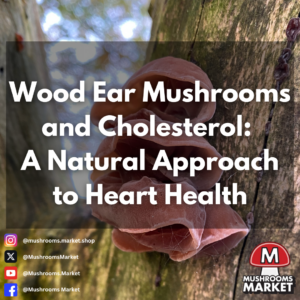
Chaga and Brain Health: Can This Antioxidant-Rich Mushroom Protect Your Mind?
In the world of natural remedies and superfoods, few have gained as much attention as functional mushrooms. Among them, Chaga (Inonotus obliquus) stands out for
5% Rewards on Every Purchase | Free Shipping On Orders $99+
Mushrooms have captivated our curiosity for centuries with their unique shapes, flavors, and health benefits. Together with their earthy flavors and captivating appearances, mushrooms have found their way into our culinary traditions, medicinal practices, scientific studies and have become a staple ingredient in cuisines worldwide.
But have you ever wondered how these fascinating fungi are cultivated? In this blog post, we will delve into the captivating world of mushroom cultivation and explore the intriguing differences between fruiting bodies and mycelium—the two essential components of the mushroom life cycle.
The Mushroom Life Cycle
To understand how mushrooms are grown, we must first familiarize ourselves with the mushroom life cycle. It begins with tiny spores, which are similar to seeds. When conditions are favorable, the spores germinate and develop into fine, thread-like structures known as mycelium. Mycelium is the Underground Network it serves as the vegetative part of the mushroom and is responsible for nutrient absorption and decomposition. It consists of a vast network of thread-like filaments called hyphae. Mycelium plays a crucial role in breaking down organic matter in nature, such as decaying trees or compost piles, facilitating nutrient cycling.
To grow mushrooms, the cultivation process starts with preparing a suitable substrate—a material that supports the growth of mycelium. Common substrates include straw, wood chips, sawdust, or agricultural waste, depending on the mushroom species. These materials are sterilized or pasteurized to eliminate competing organisms and create a favorable environment for the mycelium to thrive. Once the substrate is prepared, it’s time for inoculation. Inoculation involves introducing mycelium into the substrate. This can be done using a culture syringe, grain spawn, or agar plates containing pure mycelium. The mycelium grows and colonizes the substrate, breaking it down and establishing a strong network. After the mycelium has fully colonized the substrate, environmental conditions such as temperature, humidity, and light are carefully manipulated to initiate the fruiting stage. This stimulates the mycelium to transition from its vegetative growth phase to the reproductive phase, leading to the formation of fruiting bodies—what we commonly recognize as mushrooms. Under the appropriate conditions, pinheads begin to emerge from the mycelium, gradually developing into mature mushrooms. The fruiting bodies absorb nutrients from the substrate and continue to grow until they reach their full size. It’s important to maintain ideal conditions during this phase to ensure proper development and prevent issues such as mold or bacterial contamination. Once the mushrooms have fully matured, they are carefully harvested by gently twisting or cutting them at the base of the stem. It’s essential to harvest mushrooms at the right time to ensure optimal flavor and texture. As mushrooms reach maturity, they release spores, which can be collected for future cultivation or to study their unique characteristics.
After harvest, the mycelium can be used to expand the cultivation process further. It can be transferred to new substrates, creating more spawn, and initiating the cycle again. This expansion allows for continued cultivation and the possibility of experimenting with different substrates and growing techniques.
Now, you have a knowledge on the life cycle of a mushroom. Let’s proceed by digging deeper into the Fruiting Bodies and Mycelium.
Fruiting Bodies and Mycelium are two distinct components of the mushroom life cycle, each playing a vital role in the growth and reproduction of mushrooms. Mushroom is the “fruiting body” of a fungal organism called a basidiomycete (except with the cordyceps mushrooms because they are an organism called an ascomycete). Basidiomycetes have three distinct parts that develop throughout its lifecycle: spore, mycelium, and mushroom.
Let’s explore the differences between them:
Fruiting Bodies:
Fruiting bodies are the visible, above-ground structures that we commonly recognize as mushrooms. They are the reproductive structures of mushrooms and are responsible for producing spores. Fruiting bodies come in a variety of shapes, sizes, and colors, depending on the mushroom species. They typically consist of a cap (pileus), a stalk (stipe), and sometimes gills or pores on the underside of the cap.
The purpose of fruiting bodies is to release spores into the surrounding environment. These spores, similar to seeds, can disperse and germinate under favorable conditions to initiate new mycelial growth. Fruiting bodies are often the part of the mushroom that we consume for culinary purposes, thanks to their unique flavors and textures.
Mycelium:
Mycelium, on the other hand, is the vegetative part of the mushroom. It is composed of a vast network of fine, thread-like filaments called hyphae. Mycelium grows underground or within the substrate, forming a complex web that extends its reach in search of nutrients.
The primary function of mycelium is nutrient absorption and decomposition. It acts as a powerful decomposer, breaking down organic matter and converting it into simpler compounds that can be utilized by the mushroom for growth and development. Mycelium plays a crucial role in the ecosystem, facilitating nutrient cycling and acting as a natural recycler of organic materials. Mycelium serves as the precursor to the formation of fruiting bodies. When conditions are favorable, such as the right combination of temperature, humidity, and light, the mycelium undergoes a transition from vegetative growth to the reproductive phase, triggering the development of fruiting bodies.
In summary, fruiting bodies are the reproductive structures of mushrooms, responsible for spore production and dispersal, while mycelium is the vegetative part that functions in nutrient absorption and decomposition. The two are interconnected and represent different stages in the life cycle of mushrooms. Understanding their roles and characteristics is essential for successful mushroom cultivation. Using all the parts of the fungi might seem like an effective way to reap the most benefits. However, there are parts of the basidiomycete, like the mushroom (fruiting body), that contain more active beneficial compounds than others. The mycelium, on the other hand, is typically grown on a solid substrate which will become part of the finished product. Remember, it is important to reiterate that just as a mushroom is not mycelium, mycelium is also not a mushroom. These terms are not synonymous and should be accurately differentiated.
Conclusion:
Unveiling and understanding how mushrooms are grown provides a deeper appreciation for these remarkable organisms. It reveals a fascinating journey from the growth of mycelium to the emergence of fruiting bodies. Appreciating the differences between fruiting bodies and mycelium enhances our understanding of these enigmatic organisms. Furthermore, the cultivation process is a delicate balance of science and art. Whether you’re a hobbyist or a commercial grower, exploring the fascinating world of mushrooms opens up a world of possibilities. So, why not embark on your own mushroom-growing adventure and witness the incredible transformation from mycelium to delectable.

In the world of natural remedies and superfoods, few have gained as much attention as functional mushrooms. Among them, Chaga (Inonotus obliquus) stands out for

In today’s fast-paced, screen-saturated world, more and more people are struggling with brain fog—that frustrating feeling of mental cloudiness, poor focus, and sluggish thinking. Whether

Wood Ear mushrooms (Auricularia auricula-judae), known for their crunchy texture and subtle flavor, are more than just a staple in Asian cuisine—they might also be